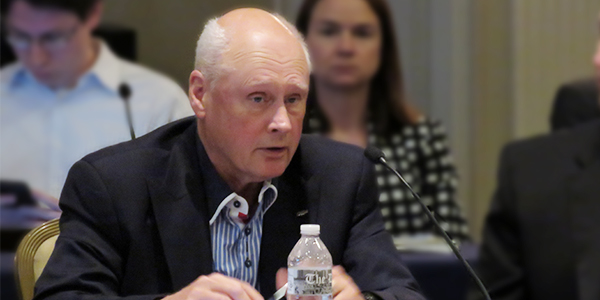By Rory D. Sweeney
WILMINGTON, Del. — PJM’s Board of Managers has signaled that it is done waiting for stakeholders to make progress on a nearly yearlong initiative to improve energy price formation.
In a letter dated Dec. 5, the board gave stakeholders until Jan. 31 to reach any consensus they can on six energy price formation issues. After that, the board threatened, it will direct PJM to seek FERC approval for the changes without member endorsement under Section 206 of the Federal Power Act.
The six areas for changes include:
- Consolidation of Tier 1 and Tier 2 synchronized reserve products;
- Improved utilization of existing capability for locational reserve needs;
- Alignment of market-based reserve products in day-ahead and real-time energy markets;
- Operating reserve demand curves (ORDCs) for all reserve products;
- Increased penalty factors to ORDCs to ensure utilization of all supply prior to a reserve shortage; and
- A transitional mechanism for the Reliability Pricing Model energy and ancillary services revenue offset to reflect expected changes in revenues in the determination of the net cost of new entry.

“The board has reviewed evidence that demonstrates that when the system is experiencing stressed conditions, energy and reserve prices do not accurately reflect PJM operator reliability actions and, as a result, out-of-market payments increase substantially during those periods,” the letter, signed by Board Chair Ake Almgren said. “Further, PJM’s current reserve market rules do not accurately align the procurement of reserves with their reliability value or incentivize consistent response when deployed. The lack of alignment in the reserve markets mutes price transparency, shifts costs unfairly to consumers who have prudently hedged and limits competition to secure reserves at the least cost to consumers.”
The board said stakeholder discussions have shown “widespread agreement that improvements to reserve markets are necessary” and that PJM has proposed to stakeholders elements from other regions that have “successfully implemented … more robust designs [that] more effectively value reserves and price operator actions.”
The Energy Price Formation Senior Task Force last month delayed a vote on competing proposals from PJM and its Independent Market Monitor for revising the RTO’s ORDC. Stakeholders had expressed reservations about both plans. (See PJM, Monitor Remain at Odds over Energy Market Proposals.)
MRC Response
PJM CEO Andy Ott opened Thursday’s meeting of the Markets and Reliability Committee by saying the changes are “critical to the ongoing evolution of our market” and that, “frankly, we think [the market rules] fall short today.” He noted price spikes during extreme weather, first highlighted by the polar vortex in 2016, and thought some of the proposals, such as locational reserves, were “low-hanging fruit” that stakeholders would endorse “in the time period that’s necessary.”
“We really believe a comprehensive solution to this is necessary. I wish that stakeholders would have come to consensus,” he said.
The forced deadline irritated some stakeholders and found support from others.
“We think that stakeholders have been working assiduously on this, and we’re disappointed that PJM and the board think differently,” said Carl Johnson, who represents the PJM Public Power Coalition. He noted that newly proposed ORDCs were introduced last week and said setting up an Enhanced Liaison Committee, used once before to implement the Capacity Performance construct, is the tool available to the board for expediting the stakeholder process, not making threats.
Susan Bruce, who represents the PJM Industrial Customer Coalition, said stakeholders have not addressed some of the topics the board has asked for agreement on, such as alignment between day-ahead and real-time markets and aligning penalty factors.
“Those are issues that we haven’t really tackled and we don’t really have any information about,” she said, asking PJM staff to provide information for stakeholders to analyze because “the calendar is creeping” up to the deadline.
“That will happen. Where’s [PJM Senior Vice President of Operations and Markets Stu] Bresler? Make that happen,” Ott said, assuring stakeholders that the board wants member input “so when we do present a package to FERC, it is as vetted as possible.”
NRG Energy’s Neal Fitch said many of the topics are “evergreen,” and “we could as stakeholders talk about this for a very long time.” He said the Enhanced Liaison Committee might not be the right plan.
“Perhaps calling the question in the very near future is the right thing to do,” he said. “We’ve been working on this for a very long time. … I think it’s time for us to move on.”
“From my perspective, the stakeholder group is actually moving in a negative direction,” Calpine’s David “Scarp” Scarpignato said. He questioned whether stakeholders should have Section 205 rights in the FPA over market rules in PJM’s Operating Agreement because of how the stakeholder process gets bogged down. He said he doesn’t agree with everything in PJM’s proposal, like the transition plan, “but eventually you have to make a decision.”


